Evacuation in an Underground Space: A Real-Time Investigation of Occupants’ Travel Speed in Clear and Smoked Environments
Abstract
:1. Introduction
2. Methodology
- The underground space in which the experiment will take place;
- The volunteers that will participate in the experiment—drill;
- The necessary hardware that will control and record the experimental results.
2.1. Analysis of the Selected Underground Area
2.2. Participants Description
2.3. Experiment Conduction Methodology
3. Examined Scenarios
Two Evacuation Scenarios Were Examined
4. Results—Discussion
4.1. First Evacuation Drill—Clear Environment
4.2. Second Evacuation Drill—Smoke Environment
4.3. Participant Survey
5. Conclusions
Author Contributions
Funding
Institutional Review Board Statement
Informed Consent Statement
Conflicts of Interest
Appendix A

| ID | Age | Evacuation Time (min:sec) | Corridor Speed (m/s) | Tunnel Speed (m/s) | Staircase Speed (m/s) |
|---|---|---|---|---|---|
| ID1 | 32 | 2:22 | 1.42 | 1.30 | |
| ID2 | 20 | 2:29 | 1.25 | 1.37 | |
| ID3 | 30 | 2:35 | 1.00 | 1.22 | |
| ID4 | 24 | 2:40 | 1.36 | 1.22 | |
| ID5 | 21 | 2:42 | 0.63 | 1.22 | |
| ID6 | 24 | 2:42 | 1.70 | 1.23 | |
| ID7 | 35 | 2:44 | 1.10 | 1.14 | |
| ID8 | 35 | 2:45 | 0.83 | 1.13 | |
| ID9 | 22 | 2:47 | 1.25 | 1.22 | |
| ID10 | 21 | 2:51 | 1.13 | 1.19 | |
| ID11 | 24 | 2:53 | 1.00 | 1.17 | |
| ID12 | 26 | 2:57 | 1.38 | 1.13 | |
| ID13 | 47 | 3:01 | 1.25 | 1.13 | |
| ID14 | 15 | 3:03 | 1.25 | 1.11 | |
| ID15 | 15 | 3:13 | 1.25 | 1.05 | |
| ID16 | 15 | 3:13 | 1.36 | 1.05 | |
| ID17 | 68 | 3:20 | 1.07 | 1.02 | |
| ID18 | 63 | 3:22 | 1.00 | 0.95 | |
| ID19 | 66 | 3:25 | 1.00 | 1.01 | |
| ID20 | 24 | 2:50 | 1.25 | 0.56 | |
| ID21 | 27 | 2:52 | 0.83 | 0.59 | |
| ID22 | 60 | 2:53 | 1.00 | 0.53 | |
| ID23 | 15 | 2:54 | 1.25 | 0.55 | |
| ID24 | 15 | 2:54 | 1.25 | 0.55 | |
| ID25 | 24 | 3:05 | 0.83 | 0.54 | |
| ID26 | 28 | 3:08 | 0.83 | 0.54 | |
| ID27 | 15 | 3:10 | 1.00 | 0.54 | |
| ID28 | 25 | 3:22 | 1.25 | 0.49 | |
| ID29 | 24 | 3:29 | 1.00 | 0.48 | |
| ID30 | 26 | 3:30 | 1.00 | 0.49 | |
| ID31 | 39 | 3:31 | 0.92 | 0.48 | |
| ID32 | 15 | 3:32 | 1.25 | 0.49 | |
| ID33 | 15 | 3:32 | 1.25 | 0.49 | |
| ID34 | 19 | 3:34 | 1.43 | 0.50 | |
| ID35 | 15 | 3:35 | 1.13 | 0.49 | |
| ID36 | 15 | 3:35 | 1.25 | 0.49 | |
| ID37 | 25 | 3:38 | 1.13 | 0.44 | |
| ID38 | 25 | 3:39 | 1.25 | 0.49 | |
| ID39 | 21 | 3:39 | 1.13 | 0.50 | |
| ID40 | 26 | 3:40 | 1.19 | 0.49 |
References
- Nelson, H.E.; Mowrer, F.W. Emergency Movement. In SFPE Handbook of Fire Protection Engineering; NFPA: Quincy, MA, USA, 2002; pp. 367–380. [Google Scholar]
- Peacock, R.D.; Hoskins, B.L.; Kuligowski, E.D. Overall and Local Movement Speeds During Fire Drill Evacuations in Buildings up to 31 Stories. In Pedestrian and Evacuation Dynamics; Springer: Gaithersburg, MD, USA, 2011; pp. 25–35. [Google Scholar]
- Kiyono, J.; Mori, N. Simulation for Emergency Evacuation Behavior During a Disaster by Use of Eliptic Distinct Elements. In 13th World Conference on Earthquake Engineering; WCEE: Vancouver, BC, Canada, 2004. [Google Scholar]
- Kobes, M.; Helsloot, I.; de Vries, B.; Post, J. Exit choice, (pre-)movement time and (pre-)evacuation behaviour in hotel fire evacuation—Behavioural analysis and validation of the use of serious gaming in experimental research. Procedia Eng. 2010, 3, 37–51. [Google Scholar] [CrossRef] [Green Version]
- Xie, R.; Pan, Y.; Zhou, T.; Ye, W. Smart safety design for fire stairways in underground space based on the ascending evacuation speed and BMI. Saf. Sci. 2020, 125, 104619. [Google Scholar] [CrossRef]
- Kady, R.A.; Davis, J. The effect of occupant characteristics on crawling speed in evacuation. Fire Saf. J. 2009, 44, 451–457. [Google Scholar] [CrossRef]
- Fridolf, K.; Nilsson, D.; Frantzic, H.; Ronchi, E.; Arias, S. Walking Speed in Smoke: Representation in Life Safety Verifications. In Proceedings of the 12th International Performance-Based Codes and Fire Safety Design Methods Conference, Oahu, HI, USA, 23–27 April 2018. [Google Scholar]
- Jin, T. Studies on Human Behavior and Tenability In Fire Smoke. Fire Saf. Sci. 1997, 5, 3–21. [Google Scholar] [CrossRef] [Green Version]
- Sun, J.; Guo, Y.; Li, C.; Lo, S.M.; Lu, S. An experimental study on individual walking speed during ship evacuation with the combined effect of heeling and trim. Ocean Eng. 2018, 166, 396–403. [Google Scholar] [CrossRef]
- Yosritzal; Kemal, B.M.; Purnawan; Putra, H. An observation of the walking speed of evacuees during a simulated tsunami evacuation in Padang, Indonesia. In Proceedings of the 4th International Conference on Civil and Environmental Engineering for Sustainability (IConCEES 2017), Langkawi, MA, USA, 4–5 December 2017. [Google Scholar]
- Akizuki, Y.; Tanaka, T.; Yamao, K. Calculation Model for Travel Speed and Psychological State in in Escape Route considering Luminous Condition, Smoke Density and Evacuee’s Visual Acuity. Fire Saf. Sci. 2008, 9, 365–376. [Google Scholar] [CrossRef] [Green Version]
- NFPA-130. Standard for Fixed Guideway Transit and Passenger Rail Systems; National Fire Protection Agency: Quincy, MA, USA, 2010. [Google Scholar]
- Ronchi, E.; Fridolf, K.; Frantzich, H.; Nilsson, D.; Walter, A.L.; Modig, H. A tunnel evacuation experiment on movement speed and exit choice in smoke. Fire Saf. J. 2018, 97, 126–136. [Google Scholar] [CrossRef]
- Yoon, E.-H.; Lee, M.-J.; Yee, J.-J. An Experimental Study on Evacuation Times in a Subway Station Using Evacuation Parameters. J. Asian Archit. Build. Eng. 2013, 12, 93–100. [Google Scholar] [CrossRef] [Green Version]
- Zhang, Y.-C.; Zhou, A.; Xiang, Y.; He, C.; Jiao, Q.; Wan, B.; Xie, W. Evacuation experiments in vertical exit passages in an underwater road shield tunnel. Phys. A Stat. Mech. Its Appl. 2018, 512, 1140–1151. [Google Scholar] [CrossRef]
- Seike, M.; Kawabata, N.; Hasegawa, M.; Chi, L.Y. Evacuation speed distribution in smoke filled full-scale tunnel experiments. In Proceedings of the 8th International Conference Tunnel Safety and Ventilation—New Developments in Tunnel Safety, Graz, Austria, 25–26 April 2016. [Google Scholar]
- Seike, M.; Kawabata, N.; Hasegawa, M. Experiments of evacuation speed in smoke-filled tunnel. Tunn. Undergr. Space Technol. 2016, 53, 61–67. [Google Scholar] [CrossRef]
- Ronchi, E.; Norén, J.; Delin, M.; Kuklane, K.; Halder, A.; Arias, S.; Fridolf, K. Ascending Evacuation in Long Stairways: Physical Exertion, Walking Speed and Behaviour—Report 3192; Lund University: Lund, Sweden, 2015. [Google Scholar]
- Kretz, T.; Grünebohm, A.; Kessel, A.; Klüpfel, H.; Meyer-König, T.; Schreckenberg, M. Upstairs walking speed distributions on a long stairway. Saf. Sci. 2008, 46, 72–78. [Google Scholar] [CrossRef]
- Chen, J.; Wang, J.; Wang, B.; Liu, R.; Wang, Q. An experimental study of visibility effect on evacuation speed on stairs. Fire Saf. J. 2018, 96, 189–202. [Google Scholar] [CrossRef]
- Kuklane, K.; Halder, A. A model to estimate vertical speed of ascending evacuation from maximal work capacity data. Saf. Sci. 2016, 89, 369–378. [Google Scholar] [CrossRef]
- Schrom-Feiertag, H.; Matyus, T.; Stubenschrott, M.; Seer, S. Empirical Findings from an Ascending Stair Evacuation Exercise in a Subway Station. In Proceedings of the 9th International Conference on Pedestrian and Evacuation Dynamics (PED2018), Lund, Sweden, 21–24 August 2018. [Google Scholar]
- Hiroi, U.; Aoyama, J. Study About the Effect of the Signposting for Evacuation in the Underground Space. J. Disaster Res. 2016, 11, 315–321. [Google Scholar] [CrossRef]
- Proulx, G. Movement of People: The Evacuation Timing. In SFPE Handbook of Fire Protection Engineering; National Fire Protection Association: Quincy, MA, USA, 2002; Section 3; pp. 342–366. [Google Scholar]
- PIARC. Fire and Smoke Control in Road Tunnels. PIARC Committee on Road Tunnels, 1999. Available online: https://www.piarc.org/en/order-library/3854-en-Fire%20and%20Smoke%20Control%20in%20Road%20Tunnels (accessed on 5 March 2022).
- CFPA-E. Administrative Authority of Tunnels; CFPA-E-Guidelines: Zurich, Switzerland, 2009. [Google Scholar]
- DAS. Administrative Authority of Tunnels (in Greek); DAS: Athens, Greece, 2011. [Google Scholar]
- Choi, J.; Hwang, H.; Hong, W. Predicting the Probability of Evacuation. In Pedestrian and Evacuation; Springer: Gaithersburg, MD, USA, 2011; pp. 37–46. [Google Scholar]
- Fujiyama, T.; Tyler, N. Free Walking Speeds on Stairs: Effects of Stair. In Pedestrian and Evacuation Dynamics; Springer: Gaithersburg, MD, USA, 2011; pp. 95–106. [Google Scholar]
- Purser, D.A.; McAllister, J.L. Assessment of Hazards to Occupants from Smoke, Toxic Gases, and Heat. In SFPE Handbook of Fire Protection Engineering; Springer: New York, NY, USA, 2016; pp. 2308–2428. [Google Scholar]
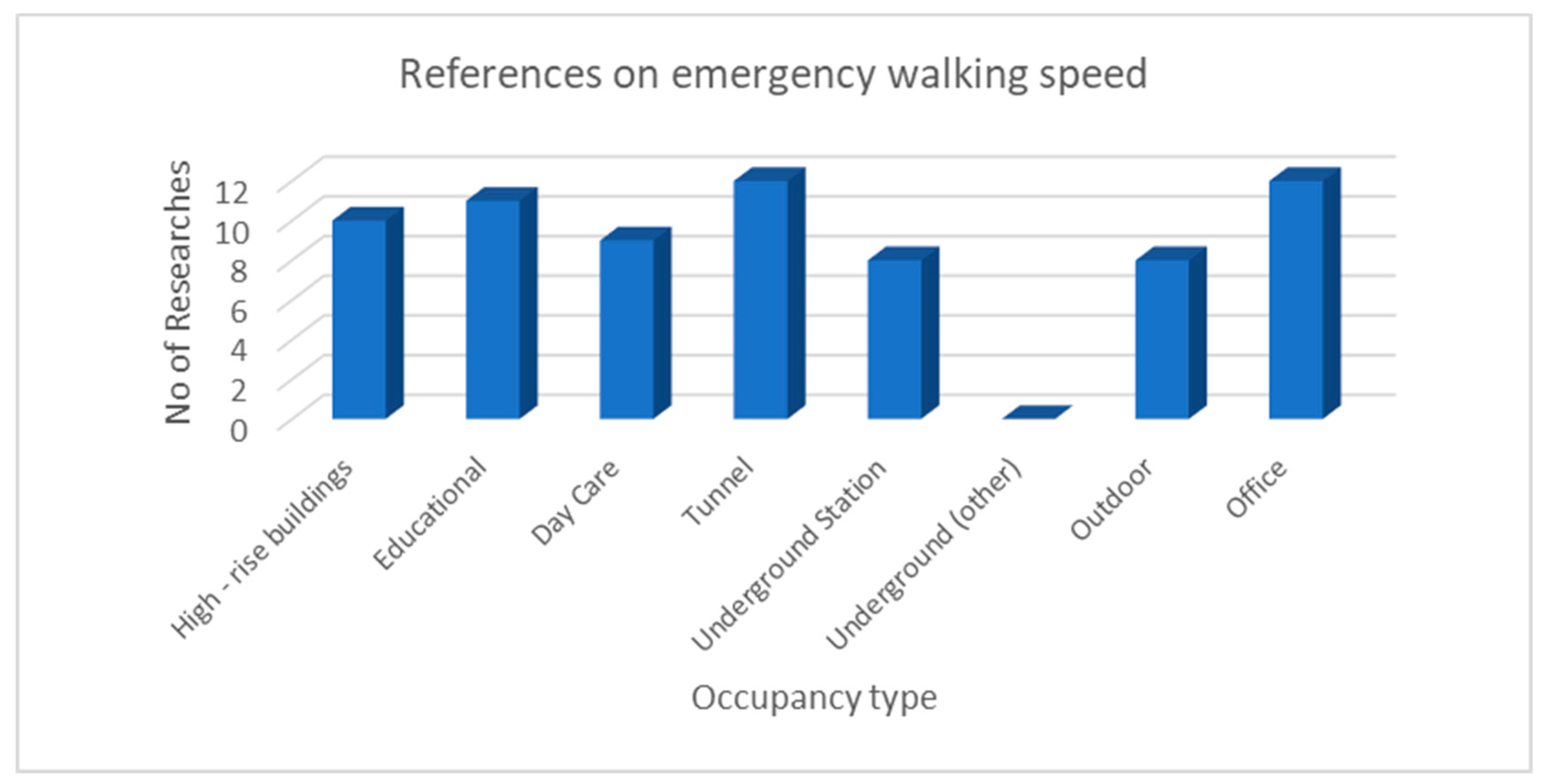















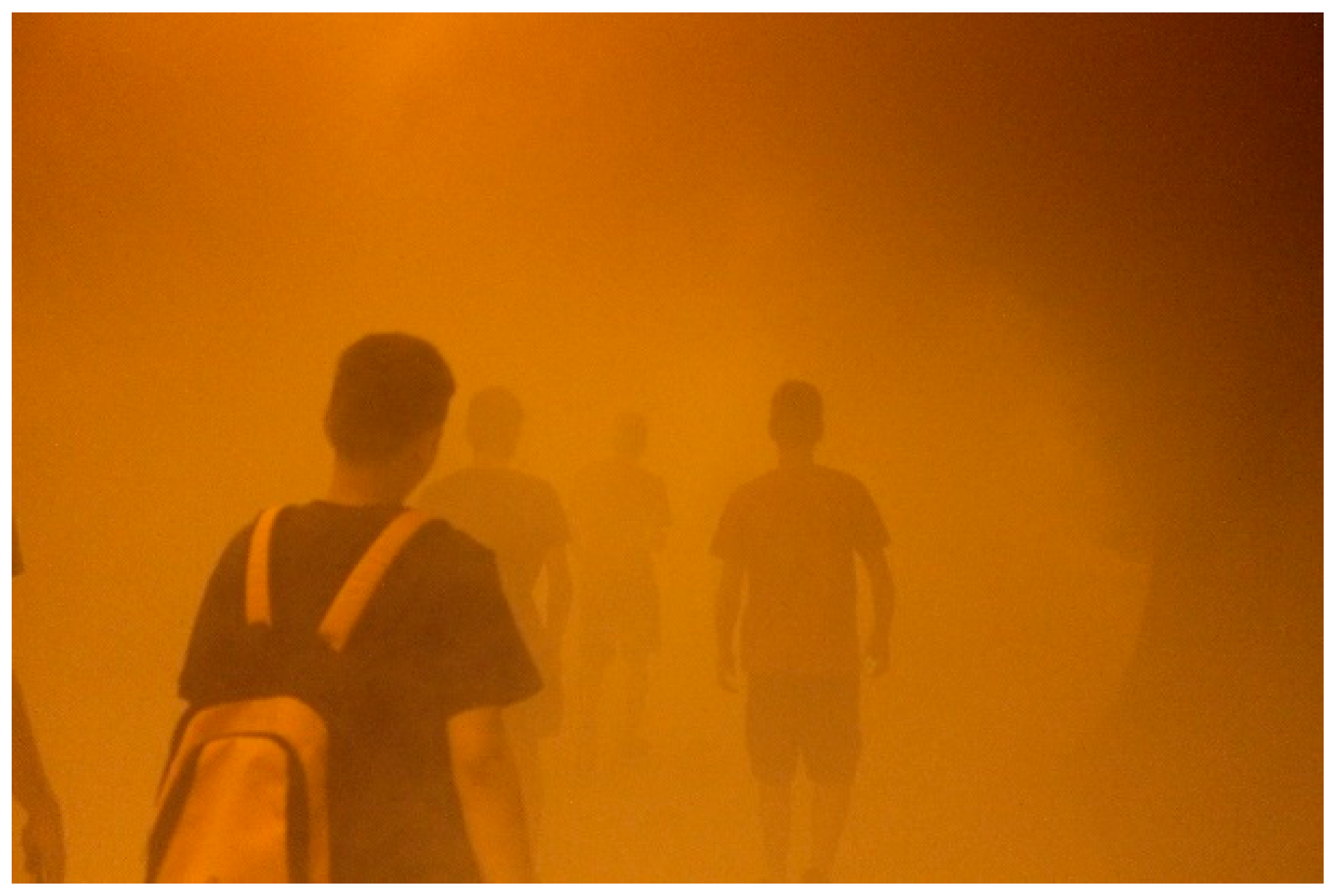
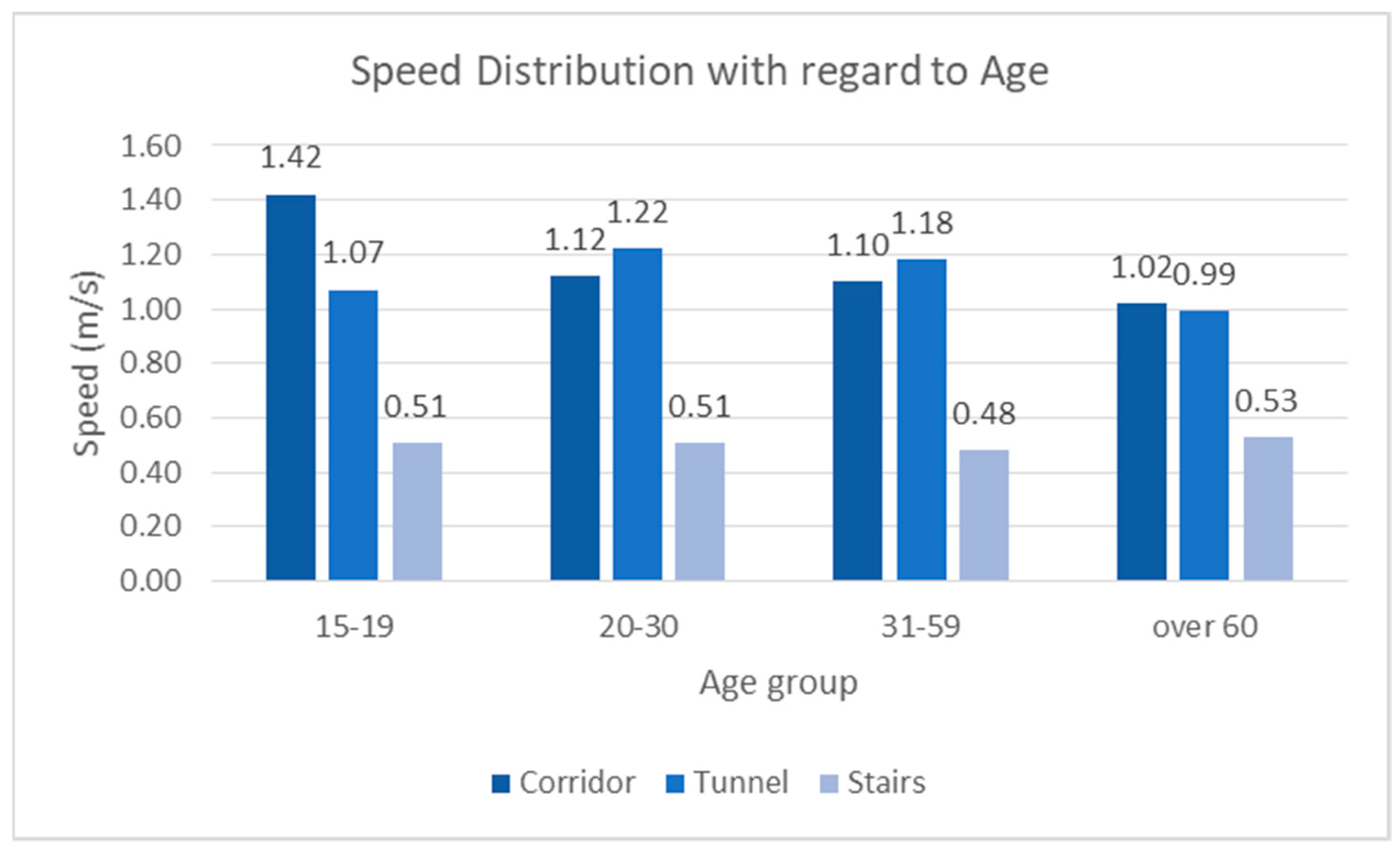


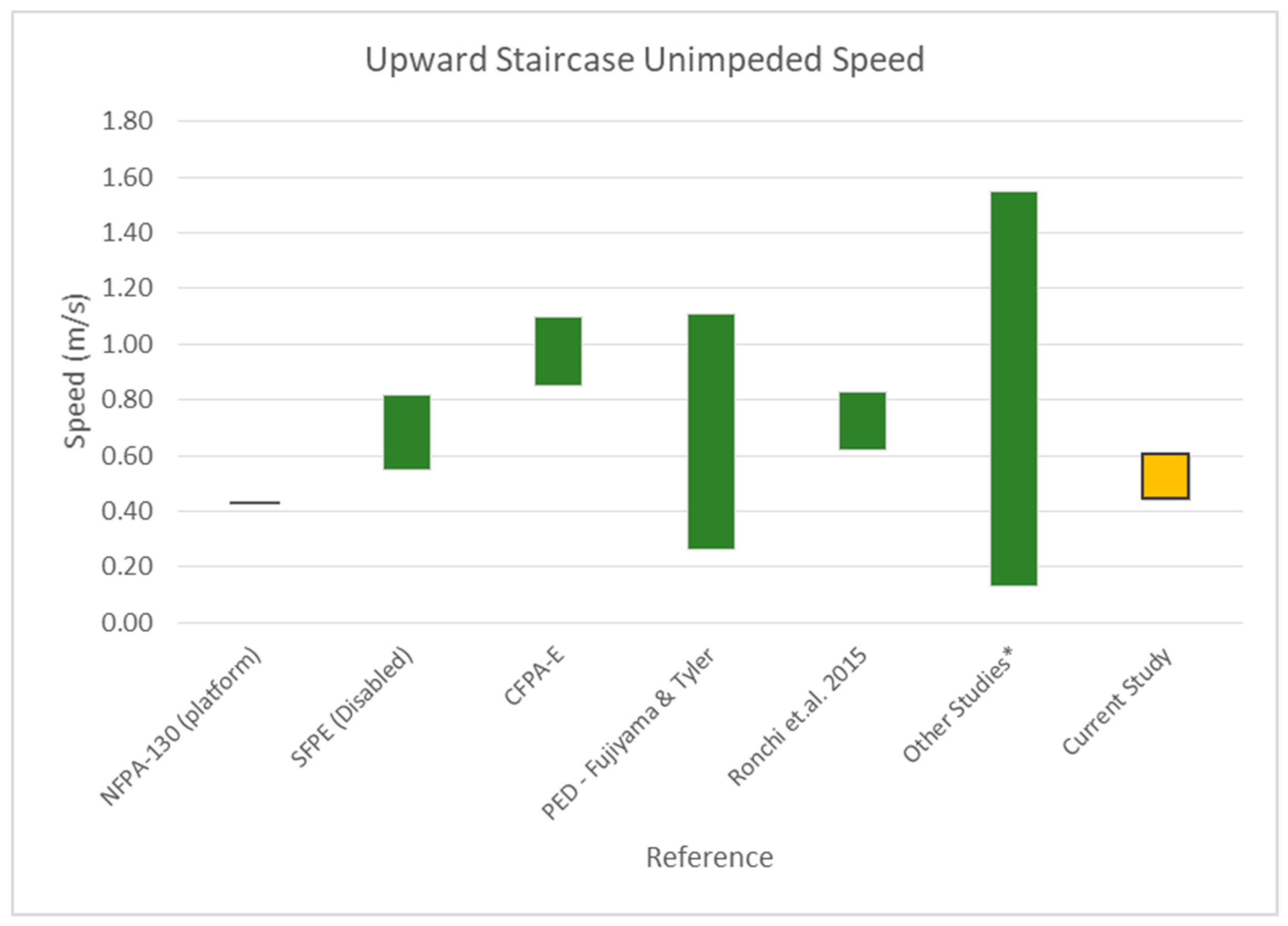

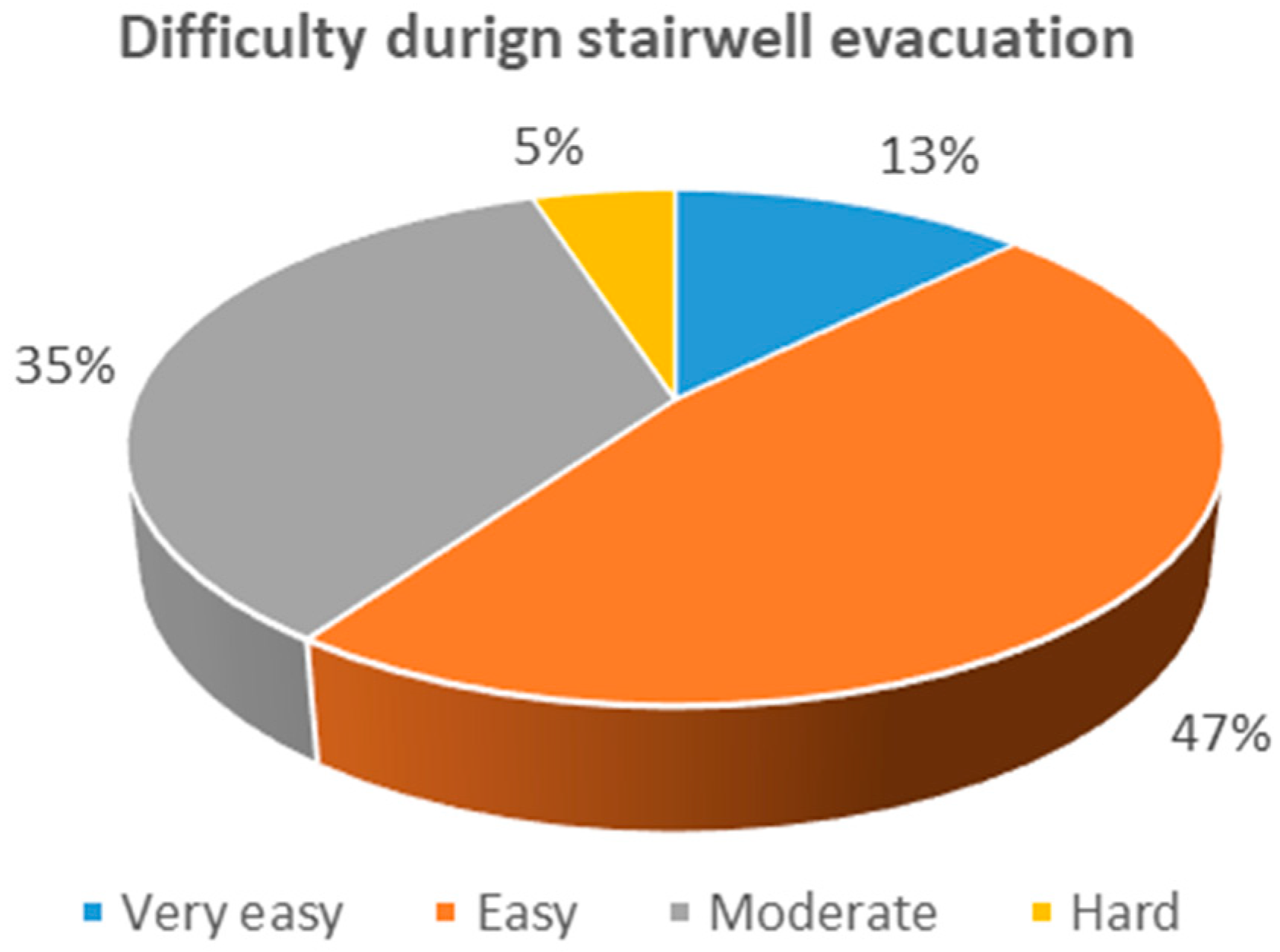
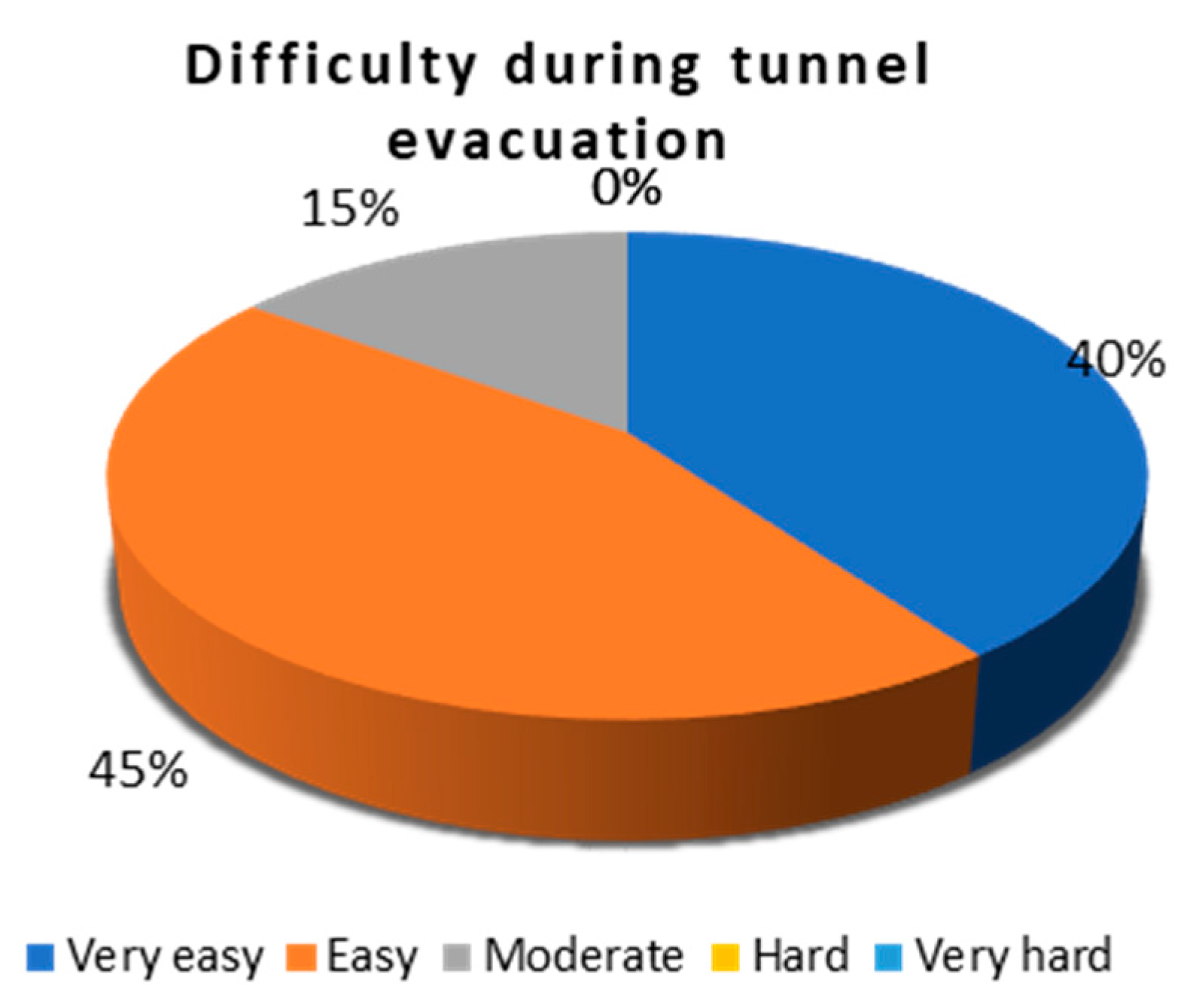



| Reference | Horizontal Surface | Upward Staircase | ||||
|---|---|---|---|---|---|---|
| Mean | Min | Max | Mean | Min | Max | |
| NFPA-130 (platform) | 0.63 | 0.43 1 | 0.43 | |||
| NFPA-130 (other areas) | 1.02 | |||||
| SFPE [24] | 1.25 | 1.25 | 1.25 | |||
| SFPE (Disabled—no locomotion) [24] | 1.25 | 0.82 | 1.77 | 0.70 | 0.55 | 0.82 |
| PIARC [25] | 1.00 | 2.00 | ||||
| CFPA-E [26] | 1.20 | 1.25 | 0.85 | 1.10 | ||
| DAS [27] | 1.00 | 1.30 | ||||
| Pedestrian and Evacuation Dynamics (PED)—Peacock et al. [2] | ||||||
| PED—Choi et al. [28] | 1.35 | 1.35 | 1.35 | |||
| PED—Fujiyama and Tyler [29] | 1.35 | 1.18 | 1.52 | 0.26 2 | 1.11 | |
| Ronchi et al.—2015 [18] | 0.62 | 0.83 | ||||
| Kretz et al.—2006 long stairways [19] | 0.52 | 0.27 | 1.55 | |||
| Kretz et al. 3—2006 short stairways [19] | 0.78 | 0.13 | 1.43 | |||
| Other Studies 4 | 0.13 | 1.55 | ||||
| Reference | Horizontal Surface | ||
|---|---|---|---|
| Mean | Min | Max | |
| Jin 5 [8] | 0.55 | 1.19 | |
| Akizuki et al. [11] | 1.10 | 0.90 | 1.30 |
| Frantzich and Nilsson [11] | 0.20 | 0.80 | |
| Fridolf et al. 6 [7] | 0.80 | 1.40 | |
| Seike et al. (normal walking) [17] | 1.40 | 1.05 | 1.88 |
| Seike et al. (emergency walking) [17] | 2.00 | 1.40 | 3.00 |
| SFPE Purser and McAllister [30] | 0.30 7 | ||
| Ronchi et al. [13] | 1.20 | 0.60 | 1.80 |
| Max | Min | Mean | Std Dev | |
|---|---|---|---|---|
| Corridor Speed | 1.70 | 0.63 | 1.14 | 0.20 |
| Tunnel Speed | 1.37 | 0.95 | 1.15 | 0.10 |
| Stairwell Speed | 0.59 | 0.44 | 0.51 | 0.03 |
| Max | Min | Mean | |
|---|---|---|---|
| Tunnel Exit | 205 | 141 | 174 |
| Stairwell Exit | 220 | 170 | 200 |
| Occupant ID | Time Travelling (sec) | Speed (m/s) |
|---|---|---|
| First | 38 | 1.08 |
| Last | 42 | 1.01 |
| Mean speed (m/s) | 1.05 | |
Publisher’s Note: MDPI stays neutral with regard to jurisdictional claims in published maps and institutional affiliations. |
© 2022 by the authors. Licensee MDPI, Basel, Switzerland. This article is an open access article distributed under the terms and conditions of the Creative Commons Attribution (CC BY) license (https://creativecommons.org/licenses/by/4.0/).
Share and Cite
Anastasios, K.; Despina, P.; Nikolas, G.; Dimitrios, K. Evacuation in an Underground Space: A Real-Time Investigation of Occupants’ Travel Speed in Clear and Smoked Environments. Infrastructures 2022, 7, 57. https://doi.org/10.3390/infrastructures7040057
Anastasios K, Despina P, Nikolas G, Dimitrios K. Evacuation in an Underground Space: A Real-Time Investigation of Occupants’ Travel Speed in Clear and Smoked Environments. Infrastructures. 2022; 7(4):57. https://doi.org/10.3390/infrastructures7040057
Chicago/Turabian StyleAnastasios, Kallianiotis, Papakonstantinou Despina, Giouzelis Nikolas, and Kaliampakos Dimitrios. 2022. "Evacuation in an Underground Space: A Real-Time Investigation of Occupants’ Travel Speed in Clear and Smoked Environments" Infrastructures 7, no. 4: 57. https://doi.org/10.3390/infrastructures7040057
APA StyleAnastasios, K., Despina, P., Nikolas, G., & Dimitrios, K. (2022). Evacuation in an Underground Space: A Real-Time Investigation of Occupants’ Travel Speed in Clear and Smoked Environments. Infrastructures, 7(4), 57. https://doi.org/10.3390/infrastructures7040057







